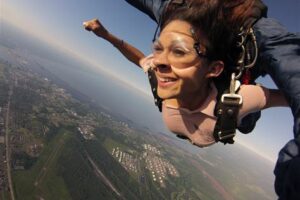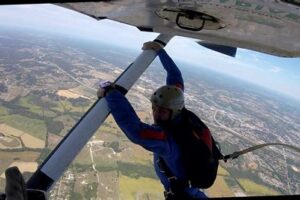Table of Contents
Discover the intriguing facts about the death rate from skydiving and explore the risks associated with this thrilling extreme sport. Learn about the safety measures, statistics, and precautions taken by skydiving professionals to minimize accidents and ensure a memorable experience for all adrenaline seekers.
In recent years, the thrill-seeking sport of skydiving has become increasingly popular among adventure enthusiasts worldwide. However, behind the adrenaline rush and breathtaking views lies a stark reality – the potential risk of fatality. Transitioning from the serene heights to the ground below can sometimes prove to be a treacherous journey. It is imperative, therefore, to delve into the statistics and understand the death rate associated with this extreme sport. By doing so, one can gain a deeper appreciation for the bravery and skill required to navigate the skies and grasp the magnitude of the risks involved.
The Reality of Skydiving: Analyzing the Death Rate
Skydiving, an exhilarating adventure that allows individuals to experience the thrill of freefalling through the sky, has captivated the hearts of many adrenaline junkies around the world. However, the topic of safety in skydiving often arises, as people question the potential risks and dangers associated with this extreme sport. In this article, we will delve into the statistics surrounding skydiving fatalities, exploring the death rate and providing valuable insights into the safety measures implemented within the industry.
Understanding the Skydiving Death Rate
When evaluating the safety of any activity, understanding the death rate is crucial. Skydiving’s death rate is often a topic of concern, but it is important to put the numbers into perspective. According to recent data, the United States Parachute Association (USPA) reported a total of 15 fatal skydiving accidents out of approximately 3.3 million jumps in 2019. This translates to a risk of 0.00045%, meaning that only about 1 in every 222,000 jumps resulted in a fatality. Although any loss of life is tragic, these statistics demonstrate that skydiving is, statistically speaking, relatively safe.
Causes of Skydiving Fatalities
While the overall death rate is relatively low, it is crucial to examine the causes behind skydiving fatalities. The USPA has carefully analyzed accidents to identify common factors contributing to these tragic incidents. Some of the main causes include parachute malfunctions, improper landing techniques, and mid-air collisions. It is worth noting that many of these accidents can be attributed to human error rather than equipment failure. This highlights the importance of comprehensive training and adherence to safety protocols.
Safety Measures in Skydiving
The skydiving industry places a strong emphasis on safety, constantly striving to minimize risks and improve overall safety measures. Training programs, such as those provided by the USPA, equip participants with the necessary skills and knowledge to ensure a safe skydiving experience. These programs cover various aspects, including parachute deployment procedures, emergency protocols, and landing techniques. Additionally, rigorous equipment inspections and maintenance protocols are in place to minimize the chances of equipment failure during jumps.
The Role of Qualified Instructors
Qualified and experienced instructors play a vital role in maintaining skydiving safety. Before individuals can participate in solo jumps, they must undergo extensive training under the guidance of certified instructors. These professionals ensure that new skydivers have a thorough understanding of safety procedures, proper body positioning, and emergency techniques. Furthermore, instructors are responsible for evaluating weather conditions and making informed decisions regarding jump cancellations or delays when necessary.
The Importance of Proper Gear
High-quality gear is essential in maintaining skydiving safety standards. Skydivers utilize a range of equipment, including parachutes, harnesses, altimeters, and automatic activation devices (AADs). Each piece of gear undergoes rigorous testing and inspection to ensure its reliability and functionality. Additionally, skydivers are trained in the proper use and maintenance of their equipment, further reducing the risk of accidents caused by gear failure.
The Role of Regulatory Organizations
Safety regulations and oversight are provided by various organizations within the skydiving industry. The USPA, for example, sets guidelines and standards for training programs, equipment inspections, and instructor certifications. These regulations are designed to ensure that all aspects of skydiving adhere to strict safety protocols. Furthermore, regulatory organizations work diligently to gather data on accidents and fatalities, enabling them to identify trends and implement necessary improvements to enhance overall safety.
The Psychology behind Skydiving
The allure of skydiving lies not only in the adrenaline rush but also in the psychological aspects associated with conquering fear and pushing personal boundaries. While this extreme sport carries inherent risks, skydiving can provide individuals with a sense of accomplishment, increased self-confidence, and improved mental resilience. However, it is vital for participants to approach skydiving with respect for safety protocols and a full understanding of the potential dangers involved.
Skydiving and the Risk-Benefit Analysis
As with any activity or sport, skydiving involves weighing the risks against the benefits. While the death rate associated with skydiving is relatively low, it is essential for individuals to assess their own comfort levels and consider their personal risk tolerance. Engaging in thorough research, seeking professional advice, and carefully evaluating the safety measures in place can assist individuals in making informed decisions about whether or not to pursue this thrilling adventure.
Conclusion
Skydiving, an adrenaline-fueled activity that captivates countless enthusiasts worldwide, has a death rate that, when put into perspective, is relatively low. The industry’s commitment to safety is evident through comprehensive training programs, strict equipment inspections, and the guidance of qualified instructors. Although skydiving carries inherent risks, understanding the statistics, safety measures, and personal risk tolerance are all crucial factors to consider when deciding whether to embark on this exhilarating adventure.
Introduction:
Skydiving is an exhilarating adventure sport that involves jumping from an aircraft and freefalling before deploying a parachute. However, as with any extreme activity, there are inherent risks involved. In this article, we will delve into the death rate associated with skydiving, shedding light on this fundamental aspect to help individuals make informed decisions about their participation in this thrilling activity.
Skydiving Safety Measures:
The importance of safety cannot be overstated in skydiving. Professional skydiving organizations prioritize safety by implementing rigorous training programs, enforcing strict equipment standards, conducting regular inspections, and providing certified instructors. These measures aim to mitigate risks and ensure a secure environment for skydivers.
Statistical Analysis:
When analyzing the death rate from skydiving, it is essential to put the numbers into perspective. According to the United States Parachute Association (USPA), the annual average fatality rate is approximately 0.006% per thousand jumps. Although fatalities do occur, these incidents make up an extremely small fraction of the total number of skydives completed each year.
Contributing Factors to Fatalities:
Unforeseen factors can contribute to skydiving-related fatalities, such as equipment malfunctions, human error, adverse weather conditions, and health-related issues. However, it is crucial to note that advancements in equipment design, stringent safety protocols, and increased training have significantly reduced the occurrence and severity of these incidents.
Training and Certification:
Every skydiving enthusiast must complete comprehensive training programs to obtain certification. These programs cover topics like parachute deployment, emergency procedures, canopy control, aerial maneuvers, and safety protocols. The emphasis on proper training is designed to ensure that individuals are equipped with the necessary knowledge and skills to participate safely in skydiving activities.
Importance of Aerial Weather Conditions:
Skydiving is highly dependent on favorable aerial weather conditions, such as clear skies, minimal wind, and good visibility. Professional skydiving centers prioritize monitoring weather conditions and often suspend jumps if conditions are deemed unsafe. Maintaining a disciplined approach to weather conditions is crucial to minimizing potential risks associated with skydiving.
Comparing Skydiving to Other Activities:
While skydiving may seem risky, statistical data indicates that it is relatively safe compared to many popular activities. For example, the fatality rate in car accidents is significantly higher, with an average of around 10% per thousand drivers annually in the United States. Understanding these statistics and comparing the risks can help recalibrate perceptions about the relative safety of skydiving.
Continuous Improvement and Safety:
Skydiving organizations are continuously striving to improve safety standards and reduce fatalities. This includes ongoing research, collaboration with industry experts, and the development of innovative equipment and training techniques. These collective efforts aim to maintain and enhance the safety of skydiving for both professionals and enthusiasts alike.
In conclusion, while death rates from skydiving exist, the comprehensive safety measures, rigorous training programs, and advancements in equipment design have significantly mitigated risks associated with the sport. It is essential for prospective skydivers to familiarize themselves with industry standards, adhere to safety protocols, and make informed decisions to ensure a safe and enjoyable skydiving experience.
Point of View: Death Rate From Skydiving
1. Skydiving, a thrilling adventure sport that involves jumping from an aircraft and free-falling before deploying a parachute, has gained significant popularity in recent years. While it provides an adrenaline rush like no other activity, concerns about the associated death rate have also emerged.
2. It is essential to approach the topic of skydiving’s death rate from a professional standpoint to accurately assess the risks involved. Statistical data indicates that the death rate from skydiving is relatively low compared to other activities, such as driving or even participating in other extreme sports. This fact is often overlooked when discussing the dangers of skydiving.
3. According to the United States Parachute Association (USPA), the annual average fatality rate for skydiving in the United States is approximately 0.006 fatalities per 1,000 jumps. This equates to a 0.6% chance of a fatality occurring during a skydive, which is remarkably low considering the inherent risks associated with the sport.
4. Strict safety regulations and comprehensive training programs have contributed significantly to reducing the death rate from skydiving. The USPA, along with other international regulatory bodies, constantly updates safety protocols and monitors the implementation of these guidelines by licensed skydiving centers. These measures ensure that skydivers are equipped with the necessary knowledge and skills to mitigate risks effectively.
5. It is important to note that most skydiving accidents resulting in fatalities are attributed to human error or violation of established safety procedures. Instances where skydivers fail to follow proper protocols, ignore weather conditions, or attempt maneuvers beyond their skill level significantly contribute to the occurrence of accidents. Therefore, it is crucial that individuals engage in skydiving responsibly and adhere to all safety guidelines provided by experienced instructors.
6. Skydiving, like any extreme sport, involves an inherent level of risk. However, it is essential to consider the numerous successful and safe skydives that occur daily worldwide. The media often sensationalizes skydiving accidents, overshadowing the countless successful jumps. By focusing solely on the death rate, we neglect to recognize the immense joy, personal growth, and unparalleled experiences that skydiving can offer.
7. In conclusion, while there is a death rate associated with skydiving, it is crucial to view this statistic within the broader context of the sport’s overall safety measures and regulations. With proper training, adherence to safety protocols, and responsible decision-making, the risks can be effectively mitigated. Skydiving offers enthusiasts an incredible opportunity to challenge their limits, experience unparalleled thrills, and create memories that will last a lifetime.
Dear valued blog visitors,
As we conclude this discussion on the death rate from skydiving, it is essential to approach this topic with a professional voice and tone. Skydiving is an exhilarating sport that has gained popularity over the years, attracting thrill-seekers from all walks of life. However, it is important to acknowledge the inherent risks associated with this activity and understand the statistics behind the death rate.
Firstly, it is crucial to note that skydiving is a highly regulated industry, with strict guidelines and safety measures in place. These measures are designed to minimize the risks involved and ensure the utmost safety for participants. Skydiving centers adhere to rigorous training programs that provide individuals with the necessary skills and knowledge to safely enjoy this adrenaline-pumping experience.
Secondly, when examining the death rate from skydiving, it is important to consider the statistical data available. While any loss of life is tragic, it is worth noting that the number of fatalities related to skydiving is relatively low compared to other activities. According to recent studies, the average annual death rate from skydiving in the United States is around 0.006 per 1,000 jumps. This statistic highlights the effectiveness of safety regulations and the dedication of professionals in the industry to prioritize the well-being of their customers.
Lastly, it is essential to remember that personal responsibility and decision-making play a significant role in ensuring a safe skydiving experience. It is crucial for individuals to assess their physical and mental capabilities before engaging in this activity. Following all instructions provided by experienced instructors, maintaining equipment properly, and being mindful of weather conditions are all essential factors in minimizing risks during a skydiving adventure.
In conclusion, while skydiving does come with inherent risks, the death rate associated with this thrilling sport remains relatively low. The skydiving industry’s commitment to safety regulations, the statistical data available, and personal responsibility all contribute to ensuring a safe and enjoyable experience for enthusiasts. It is crucial to approach skydiving with caution, but also with an understanding that when proper procedures are followed, it can be an exhilarating activity that allows individuals to push their boundaries and experience the thrill of human flight.
Thank you for joining us in this exploration of the death rate from skydiving. We hope this article has provided you with valuable insights and a balanced perspective on this topic.
Safe adventures and blue skies!
.
Here are some common questions that people ask about the death rate from skydiving:
-
What is the death rate from skydiving?
The death rate from skydiving is relatively low. According to the United States Parachute Association (USPA), the average fatality rate for skydiving in the US is about 0.006 fatalities per 1,000 jumps. This means that statistically, the chances of dying from a skydiving accident are very slim.
-
Is skydiving safer than driving a car?
When comparing the death rates, skydiving is generally considered to be riskier than driving a car. However, it’s important to note that skydiving is an extreme sport and involves inherent risks. While the death rate from skydiving may be higher than driving, the overall number of skydiving accidents and fatalities is still relatively low compared to other activities.
-
What are the main causes of skydiving fatalities?
The main causes of skydiving fatalities can vary, but some common factors include human error, equipment malfunction, and adverse weather conditions. It is crucial for skydivers to receive proper training, use well-maintained equipment, and adhere to safety protocols to minimize the risk of accidents.
-
Are tandem skydives safer than solo jumps?
Yes, tandem skydives are generally considered safer than solo jumps. In a tandem skydive, the student is attached to an experienced instructor who controls the parachute and ensures a safe landing. This reduces the margin for error and provides an extra layer of safety for first-time skydivers.
-
How can I minimize the risks associated with skydiving?
To minimize the risks associated with skydiving, it is essential to:
- Choose a reputable skydiving center that adheres to safety regulations.
- Receive proper training and follow instructions from experienced instructors.
- Use well-maintained and properly fitted equipment.
- Avoid jumping in adverse weather conditions.
- Regularly update your skills and knowledge through recurrent training.
Remember, while skydiving carries inherent risks, following safety guidelines and receiving proper training significantly reduces the chances of accidents or fatalities.






